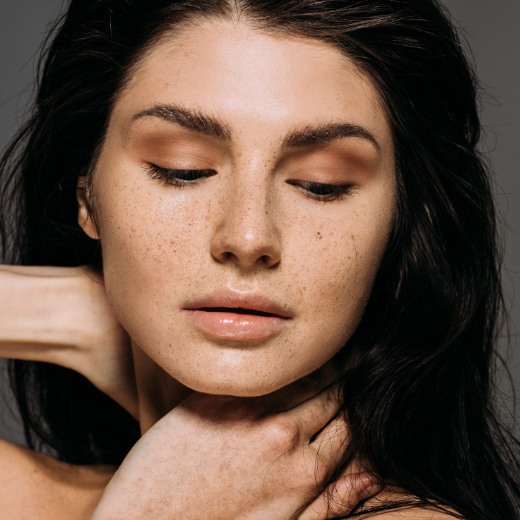Got Polka Dots? Common Types of Facial Brown Spots
Posted by Nikki Wisher on Nov 15th 2022
What does the perfect skin look like in your mind? It’s probably clear, smooth, and evenly complected – maybe with some freckles but with an otherwise even tone, right? For nearly all of us, though, when we look in the mirror, it doesn’t match. One of the most common skin complaints is patchy, blotchy brown spots. Not exactly on anyone’s wish list.
Let’s demystify those brown spots and, most importantly, find out how to get rid of them.
Top Types of Facial Brown Spots
Brown spots can come from a few different causes, and sometimes, it’s tough to know which one is the culprit for you unless you see a dermatologist. There are three top types of brown spots: age spots, melasma, and scarring or post-inflammatory hyperpigmentation.
Age Spots (AKA Sun Spots)
Age spots are incredibly common, and they can pop up at any earlier age than you expect. That’s because they aren’t actually caused by aging. They’re caused by sun damage that accumulates over the years.
Melasma
Your hormones affect just about every aspect of your body in some way, and your skin is no exception. There are some types of hormonal changes that can trigger your skin’s pigment-producing cells to create brown spots called melasma.
Melasma is typically a response to shifts in feminine hormones. It’s particularly common during pregnancy, which is why it’s sometimes called a “pregnancy mask.” It sometimes goes away when your hormones settle back into their usual routine, but not always.
Post-Inflammatory Hyperpigmentation
When your skin experiences inflammation, such as from acne, chafing, or a rash, it can leave behind brown pigmentation when it heals. This is called post-inflammatory hyperpigmentation or PIH.
PIH is often seen on people’s faces as a form of acne scarring. If you have small brown spots in an area where you’ve had acne in the past, chances are that it’s PIH. It’s important to note that while PIH is often called an acne scar, it’s not made of scar tissue – it’s only a matter of the excess pigment.
What to Do About Brown Spots
Understanding where your brown spots came from is a helpful first step, but let’s get to the goods of what you really want to know: how to get rid of brown spots. Some spots are more stubborn than others and everyone’s skin reacts differently to any product or treatment, but there are several reliable techniques you can use.
Use a Pigment Correcting Product
The skin care science world knows how much you hate your brown spots and they’re on it. There are excellent pigment correction products on the market that can ease your brown spots as part of your daily skin care routine.
There are different active ingredients that can have this effect and each one is suited to different types of skin. Make sure you choose a product that is well-suited to your skin, whether you have oily skin, dry skin, sensitive skin, and so on.
Step Up Your Sun Care
Sun exposure is the primary cause of age spots, so if your brown spots are age spots, sun protection is an obvious must. But it’s not a big deal for other types of brown spots, right?
Not exactly. Sun exposure can make any type of brown spot worse and make it more prominent – including melasma and PIH.
The solution? Use a layered approach to your sun protection. For starters, use a sunscreen every day as part of your morning skin care routine. It should be the last step before you apply your makeup. Be sure to reapply your sunscreen later in the day too, especially if you’re heading outside for a walk or anything else that will expose your skin to the sun.
In addition to sunscreen, use other sun protection measures whenever possible. As far as protecting your facial skin, that includes wearing a wide-brimmed hat, wearing sizeable sunglasses to protect the skin around your eyes, and spending most of your outdoor time in the shade.
Here’s a bonus tip: you may be able to combine brown spot correction and prevention in one product. Murad’s Correct and Protect Serum, for example, contains SPF 45 as well as pigment correction.
Consider Professional Treatments
Home skin care products are great for evening your skin tone, but they do take time, require consistent use, and have their limitations. If you want to reduce your brown spots more quickly (such as before a special event on your calendar) or more dramatically, there are professional skin treatments that can help.
Laser skin treatments are generally the most effective way to remove brown spots. They are better suited to some skin types than others, though, so there are other treatments that can be effective as well, like chemical peels. You’ll need a consultation with a skin treatment professional like a dermatologist or aesthetician to find out the best option for you.
Accomplishing Smoother, More Even Skin
Whether you’re hoping to ditch your foundation altogether or you just want to have a more even and naturally consistent complexion, brown spots often stand in the way, but they don’t have to. Use the tips and products above to reduce or remove your brown spots and to protect your skin in the long term.

